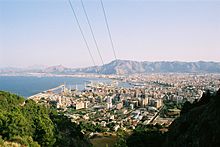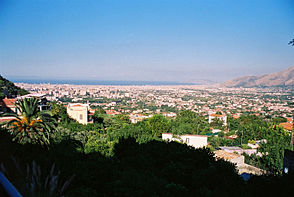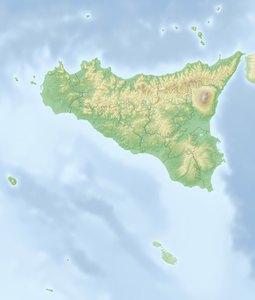Conca d'Oro
| Conca d'Oro | ||
|---|---|---|
|
The Conca d'Oro |
||
| location | Metropolitan city of Palermo , Sicily , Italy | |
| Waters | Oreto | |
| Geographical location | 38 ° 5 '18 " N , 13 ° 20' 39" E | |
|
|
||
| surface | about 100 | |


The Conca d'Oro ( English : Golden Basin ) is the plain on which the Sicilian capital Palermo and some villages in the hinterland lie. This now largely built-up plain has been a center of citrus cultivation since the conquest of Sicily by the Arabs in 831.
geography
The plain forms a basin between the Tyrrhenian Sea and the mountains of Palermo, in the middle of which stands the imposing, 609 m high Monte Pellegrino . The Oreto also flows through the valley . The Conca d'Oro extends over about 100 km². In the east the valley is bordered by the two cities of Bagheria and Villabate and a few mountains and in the west exclusively by mountains. In the north it borders the sea and in the south the valley stretches a little into the mountains of Palermo. The Oreto also flows from here. During the time of Arab rule there were numerous orange groves in the Conca d'Oro, which is where the name comes from, as the typical color of the fruit was gold .
Development
Most of the area is covered by Palermo, but the further inland you go the more undeveloped it becomes. There are still the larger cities of Monreale and Altofonte and a few smaller towns.
In the past 50 years, the area has been profoundly changed by the strong uncontrolled settlement, which is also known as "Sacco di Palermo". On most undeveloped areas is a rather unknown but very popular abroad Mandarin varieties that Mandarino tardivo di Ciaculli terraced.
Conca d'Oro, citrus cultivation and the mafia
After the Arab conquest of Sicily in 831, the bitter orange , which was more robust in cultivation, was introduced there, and later the more difficult to cultivate lemon. With the rainy winters and the dry summers, Sicily is actually not ideal for growing citrus fruits. However, based on the irrigation systems still in existence from Roman times, Arab settlers developed irrigation methods that allowed cultivation. Ibn Hauqal , who also visited Sicily on his long travels, describes in his book about the image of the earth , written down in 977, the extensive gardens around Palermo, in which orange and lemon trees grew due to the irrigation methods introduced.
Sicily developed into a major producer of lemons in the 19th century. In the 18th century the British Admiralty initially obtained its lemon juice from Spain, after the sea battle at Abukir and the subsequent conquest of Malta by British troops in 1798, Malta and Sicily became the main suppliers. When the British Admiralty switched to the cheaper lime juice from the West Indies around the middle of the 19th century, trade relations between Sicily and North America were already so extensive that this did not have any far-reaching consequences for the Sicilian economy: the first lemons from Sicily were brought to North America in 1807 and in 1830 ships loaded with oranges and lemons from Sicily ran into New York all year round.
Growing lemons was more economical than growing oranges because of the higher production volume. Lemons also survived the crossing to North America better: Before the start of steam shipping, a sailing freighter from Palermo to New York needed an average of 45 days. Accordingly, lemons accounted for two thirds of Sicily's citrus production. The profit margin from this cultivation in 1860 was also higher than any other agricultural production in Europe. The approximately 100 square kilometer Conca d'Oro plain developed into the center of cultivation in Sicily.
However, extensive investments were necessary before citrus fruits could be grown on the poor and often stony soils of the Conca d'Oro. Often it first had to be planted with opuntia to loosen the soil. Walls had to be built around the plantations to protect the young trees from both cold winds and thieves, wells had to be dug and irrigation systems installed, paths had to be built to the plantations and sheds built there to store tools and harvested fruits. Once the trees were planted, it took about eight years for them to bear fruit in any appreciable number. It was in this environment that the forms of protection racket that are associated with the mafia today emerged. It was the wealthier among the lemon growers who offered their neighbors to guard their plantations, who secured them access to water in return for payment of money, and who also made it dependent on payments whether the harvest was loaded on the ships to North America on time or whether the harvest remained lying on the harbor docks unnoticed.
literature
- Helena Attlee: The Land Where Lemons Grow: The Story of Italy and its Citrus Fruit. Penguin Books, London 2015, ISBN 978-0141-96786-8 .

